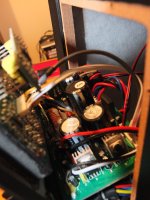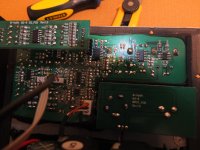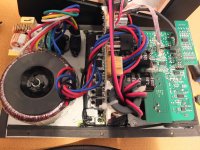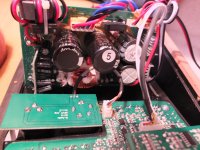Hi everyone,
I have a pair of M-Audio M3-8 active speakers and one of them started making random pop sounds. It makes me think something to do with the capacitors. Being out of warranty, M-Audio won't fix or replace them. I have opened one of them and took a look at the boards inside. I was able to list almost all the caps on the boards (they're currently all cheap chinese ones), so recapping would be a first step. Now, a friend suggested I would be looking at upgrading the opamps throughout. I am not so good with soldering and rebuilding myself, so I'll hire someone to do the soldering job.
Can you please give me some suggestions about could be upgraded? They do have some self noise, which I think can be improved by upgrading components. How would I go about reducing the gain of the amps(for normal levels I have to run the volume potentiometer pretty low)?
Please see pictures attached.
Thanks!
I have a pair of M-Audio M3-8 active speakers and one of them started making random pop sounds. It makes me think something to do with the capacitors. Being out of warranty, M-Audio won't fix or replace them. I have opened one of them and took a look at the boards inside. I was able to list almost all the caps on the boards (they're currently all cheap chinese ones), so recapping would be a first step. Now, a friend suggested I would be looking at upgrading the opamps throughout. I am not so good with soldering and rebuilding myself, so I'll hire someone to do the soldering job.
Can you please give me some suggestions about could be upgraded? They do have some self noise, which I think can be improved by upgrading components. How would I go about reducing the gain of the amps(for normal levels I have to run the volume potentiometer pretty low)?
Please see pictures attached.
Thanks!
Attachments
Just a quick update:
The opamps in these boxes are: C4558 (dual) and 047C (quad). I was thinking to upgrade them to OPA2134 and OPA 4134, respectively. Are these gonna be compatible or is there something better? So far they seem ok to me, but I'd like to hear experienced modders' opinions.
Thanks!
The opamps in these boxes are: C4558 (dual) and 047C (quad). I was thinking to upgrade them to OPA2134 and OPA 4134, respectively. Are these gonna be compatible or is there something better? So far they seem ok to me, but I'd like to hear experienced modders' opinions.
Thanks!
I very much doubt the caps are the source of the problem of random pops, likely something to do with the amplifier circuit itself.
Before modding a defective piece with random 'audio quality' mods is not advised unless you have first fixed the issue at hand. You would be best advised to take it to a good tech who can figure out the root of the problem first.
The best way to do that would be to isolate each section within the circuitry and test it separately till you find the offending module. Work backwards from the power amplifier, and test each half/third separately. It could be as simple as a failing connector or solder joint, the modules have to cope with a lot of vibration and it's quite feasible that something has shaken loose, enough to cause an intermittent fault.
Once that is done, you can worry about opamp and cap replacements. The OPA2134 and 4134 are not suitable for crossover circuits, better to use bipolar input devices. The 5532 is a good improvement over the 4558, and the 074 can be substituted with a 49740 - if you can find it. The improvements, if any, would be marginal at best because the noise at line levels are already insignificant. Maybe some reduction in idle hiss, if you have that problem.
I wouldn't worry too much about the caps, it looks like a direct coupled circuit for the most part. The crossover and amp boards have no caps on them at all, only the power and protection sections (far as I can see).
Before modding a defective piece with random 'audio quality' mods is not advised unless you have first fixed the issue at hand. You would be best advised to take it to a good tech who can figure out the root of the problem first.
The best way to do that would be to isolate each section within the circuitry and test it separately till you find the offending module. Work backwards from the power amplifier, and test each half/third separately. It could be as simple as a failing connector or solder joint, the modules have to cope with a lot of vibration and it's quite feasible that something has shaken loose, enough to cause an intermittent fault.
Once that is done, you can worry about opamp and cap replacements. The OPA2134 and 4134 are not suitable for crossover circuits, better to use bipolar input devices. The 5532 is a good improvement over the 4558, and the 074 can be substituted with a 49740 - if you can find it. The improvements, if any, would be marginal at best because the noise at line levels are already insignificant. Maybe some reduction in idle hiss, if you have that problem.
I wouldn't worry too much about the caps, it looks like a direct coupled circuit for the most part. The crossover and amp boards have no caps on them at all, only the power and protection sections (far as I can see).
Very good points from Sangram.
I would leave the amplifier(s) on the desk instead of remounting them in the box; this would allow to position the tranformer a little further, which can be a possible cause of hum...hhmm, not hissssss

Extend the 4 cables and job done...hmmm, a new back cover for the boxes
I would leave the amplifier(s) on the desk instead of remounting them in the box; this would allow to position the tranformer a little further, which can be a possible cause of hum...hhmm, not hissssss
Extend the 4 cables and job done...hmmm, a new back cover for the boxes
I very much doubt the caps are the source of the problem of random pops, likely something to do with the amplifier circuit itself.
Before modding a defective piece with random 'audio quality' mods is not advised unless you have first fixed the issue at hand. You would be best advised to take it to a good tech who can figure out the root of the problem first.
The best way to do that would be to isolate each section within the circuitry and test it separately till you find the offending module. Work backwards from the power amplifier, and test each half/third separately. It could be as simple as a failing connector or solder joint, the modules have to cope with a lot of vibration and it's quite feasible that something has shaken loose, enough to cause an intermittent fault.
Once that is done, you can worry about opamp and cap replacements. The OPA2134 and 4134 are not suitable for crossover circuits, better to use bipolar input devices. The 5532 is a good improvement over the 4558, and the 074 can be substituted with a 49740 - if you can find it. The improvements, if any, would be marginal at best because the noise at line levels are already insignificant. Maybe some reduction in idle hiss, if you have that problem.
I wouldn't worry too much about the caps, it looks like a direct coupled circuit for the most part. The crossover and amp boards have no caps on them at all, only the power and protection sections (far as I can see).
I thank you very much for your input! Well, I will take them for diagnosis for sure. Only that the tech shop I called said that if it's that intermittent will be hard to diagnose and to wait and see if it aggravates. I haven't heard a popping sound in days, now. When it happens, it sounds like a vinyl small pop in the woofer only in one speaker.
Yes, there is some idle hiss and I don't know what's causing it. There are some caps on the back of the preamp board, seen 2 small ones so far. The back is sealed with some foam and I only did a small cut and saw caps. Now, some people are blaming the self noise on the gain circuit. By the way, how could I reduce that gain? Now, I have a Benchmark DAC2 in front with attenuation pads at -20 dB already and the volume knobs on the back of the speakers are set pretty low (below 9 o'clock) to get a good volume. Otherwise the gain is very very high.
Thanks!
Very good points from Sangram.
I would leave the amplifier(s) on the desk instead of remounting them in the box; this would allow to position the tranformer a little further, which can be a possible cause of hum...hhmm, not hissssss
Extend the 4 cables and job done...hmmm, a new back cover for the boxes
I thought about that, too. It's doable, but a little bit too complicated. There may be a chance to get them to perform well with the amps in the box. We'll see. I'm not doing anything to them yet, just documenting myself. I'm not an expert, that's why I posted here.
Another update: the idle noise...as I said, it's always there. But I tried this today: stayed very close and listened to the drivers and moved the volume potentiometer up and down. It's always there, but it increases as I move the pot to a louder position. So I think it's a gain circuit thing.
- Status
- This old topic is closed. If you want to reopen this topic, contact a moderator using the "Report Post" button.
- Home
- Amplifiers
- Solid State
- M-Audio M3-8 active speakers modification



